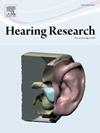Disrupted fundamental frequency encoding in sensorineural hearing loss revealed by the frequency-following response
IF 2.5
2区 医学
Q1 AUDIOLOGY & SPEECH-LANGUAGE PATHOLOGY
引用次数: 0
Abstract
Objectives
The frequency-following response (FFR) is a scalp-recorded auditory evoked potential that reflects subcortical and cortical encoding of speech through neural phase-locking to its spectro-temporal features. Previous research on the influence of sensorineural hearing loss (SNHL) on the FFR has been inconsistent, with a tendency towards smaller spectral amplitudes at the fundamental frequency (F0), however often limited by small samples, use of short stimuli that prevent proper phase locking, and poor control for audibility.
Methods
Seventy adults (18–65 years) with normal hearing or various degrees of SNHL were included. Pure-tone audiometry (PTA) and speech-in-noise tests were performed. FFRs were recorded using the 217 ms /dao/ stimulus presented monaurally in three randomized blocks of 1000 trials each. Stimuli were calibrated to 60 dB above the mean PTA threshold (at 0.5, 1, and 2 kHz) or adjusted to maximum comfortable loudness level.
Results
Significant correlations were found between the PTA and both the F0 response amplitude and the signal-to-noise ratio (SNR) at F0 for the /o/ section of the stimulus (r = -0.341 and r = -0.438, respectively; p < 0.001). Stimulus-to-response cross-correlation, pitch error, and pitch strength for both /a/ and /o/ segments were also significantly associated with PTA. Most speech-in-noise tests correlated significantly with the SNR at F0 for the /o/ segment.
Conclusions
Our findings demonstrate that SNHL disrupts subcortical encoding of the fundamental frequency, particularly in the /o/ vowel segment. These results highlight the potential of the FFR as an objective marker of auditory processing deficits associated with SNHL.
由频率跟随反应揭示的感音神经性听力损失的基频编码中断
目的频率跟随反应(FFR)是一种头皮记录的听觉诱发电位,通过神经锁相来反映言语的皮层下和皮层编码。以往关于感音神经性听力损失(SNHL)对FFR影响的研究一直不一致,在基频(F0)上倾向于较小的频谱幅度,但往往受到样本小、使用短刺激导致无法正确锁相以及可听性控制差的限制。方法选取听力正常或不同程度SNHL的成年人70例(18 ~ 65岁)。进行了纯音测听(PTA)和噪声中语音测试。使用217 ms /dao/刺激记录ffr,随机分为三个组,每个组1000个试验。刺激被校准到高于平均PTA阈值(0.5,1和2 kHz) 60 dB或调整到最大舒适响度水平。结果对于刺激的/o/部分,PTA与F0反应幅度和F0时的信噪比(SNR)存在显著相关(r = -0.341和r = -0.438; p < 0.001)。/a/和/o/段的刺激-反应互相关、音调误差和音调强度也与PTA显著相关。大多数语音噪声测试与/o/段F0处的信噪比显著相关。结论SNHL破坏了皮层下基频编码,特别是/o/元音片段。这些结果突出了FFR作为SNHL相关听觉加工缺陷客观标记的潜力。
本文章由计算机程序翻译,如有差异,请以英文原文为准。
求助全文
约1分钟内获得全文
求助全文
来源期刊

Hearing Research
医学-耳鼻喉科学
CiteScore
5.30
自引率
14.30%
发文量
163
审稿时长
75 days
期刊介绍:
The aim of the journal is to provide a forum for papers concerned with basic peripheral and central auditory mechanisms. Emphasis is on experimental and clinical studies, but theoretical and methodological papers will also be considered. The journal publishes original research papers, review and mini- review articles, rapid communications, method/protocol and perspective articles.
Papers submitted should deal with auditory anatomy, physiology, psychophysics, imaging, modeling and behavioural studies in animals and humans, as well as hearing aids and cochlear implants. Papers dealing with the vestibular system are also considered for publication. Papers on comparative aspects of hearing and on effects of drugs and environmental contaminants on hearing function will also be considered. Clinical papers will be accepted when they contribute to the understanding of normal and pathological hearing functions.
 求助内容:
求助内容: 应助结果提醒方式:
应助结果提醒方式:


